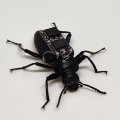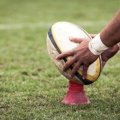The University of Queensland will play an important role in an unmanned Japanese flight to an asteroid in 2002 to retrieve the first extra-terrestrial matter since the end of the Apollo program.
The world's largest and fastest superorbital ground test facility, the University's X3 superorbital expansion tube, will be the key test facility for a model of the project's re-entry capsule.
The capsule is expected to re-enter the earth's atmosphere at 13km/second, compared with 11km/second re-entry achieved by the Apollo capsules. It will be the fastest re-entry and recovery ever attempted of a space vehicle.
The only facilities on earth capable of achieving these speeds are the University of Queensland's X1 and X2 superorbital expansion tubes, and the larger-diameter X3 expected to come on-line in the next 18 months. 1/10 scale models will be tested in X2, commissioned in 1995/96 by Con Doolan during his PhD studies.
The X3 is designed to reach speeds of 15km/second or Mach 45 - 45 times the speed of sound. It will be 65 metres long and have a bore diameter of 180mm.
The University is working closely with the Japanese Institute for Space and Astronautical Science (ISAS) and Tohoku University, Japan on the project, which targets the asteroid, Nereus, beyond the planet Mars.
The collaboration with the Japanese group led by Professor Kazuyoshi Takayama began following a visit by University of Queensland project leader Associate Professor Richard Morgan and Emeritus Professor Ray Stalker to ISAS last year.
Dr Morgan commissioned the X1 in 1990 and is in charge of design for the X3.
He said the return flight to Nereus, known as the Muses C project, would take a total four years, with a projected 2006 Earth re-entry.
The vehicle's mission is to dig up 10g of matter on arrival at Nereus, and return with it to Earth. However, Nereus has little gravity so novel methods are being designed both to land the craft, and to capture the extra-terrestrial matter.
University of Queensland undergraduate student Scott Thompson (bachelor of engineering, mechanical and space) is designing a gun to shoot into the asteroid, breaking up surface matter which will be collected in a conical scoop for return to Earth.
Dr Morgan said the tiny space craft would carry a payload of 8kg and have thermal protection shields weighing 10gm to protect it as it re-entered Earth's atmosphere.
'The payload is small because of unknown factors associated with aerodynamic efforts governing erosion of the heat shield,' he said.
'By testing the re-entry capsule in superorbital facilites at the University of Queensland, important data may be obtained to enable the heat shield to be designed more efficiently.
'This will make the mission more likely to succeed and possibly will lead to an increased payload size,' he said.
Japanese PhD student Kazuyuki Yada is currently studying at the University of Queensland on a Japanese Government scholarship as part of the project.
Tohoku University, which is supporting the project, is building a copy of the Australian superorbital expansion facilities, known as the JX1.
The new project builds on technology developed over the past 30 years by Emeritus Professor Ray Stalker and his Mechanical Engineering Department colleagues to establish free piston-driven shock tunnels with earth orbital velocity simulation capability.
The Australian Research Council, the University of Queensland and NASA Langley are supporting the X3 and related studies.
Dr Morgan said the project had the backup support of the largest team of academics, postdoctoral fellows and postgraduate students in aerospace engineering at any Australian university, plus expert technicians from the Mechanical Engineering and Physics Departments' workshops.
It also builds on the expertise of the University of Queensland Physics Department's optics group, led by Associate Professor Halina Rubinsztein-Dunlop, who is developing non-intrusive measurement techniques in the expansion tubes.
For further information, contact Dr Morgan, telephone 07 3365 3592.
.jpg)

